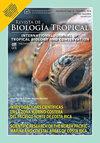安第斯河流网中鱼类多样性的分布
IF 0.6
4区 生物学
Q4 BIOLOGY
引用次数: 0
摘要
哥伦比亚安第斯山脉淡水鱼的分布是历史和现代因素相互作用的结果。目前,安第斯地貌正面临着快速的转变过程。然而,关于物种分布和环境要求的知识进展比河流网络正在进行的转变要慢。目的:在考虑伊图安戈大坝建设前当地环境背景的情况下,了解考卡河中下游流域鱼类群落的结构,量化当地鱼类群落的β多样性及其两个组成部分(周转和筑巢)。方法:在大坝运行前的9年(2010年2月至2018年11月)期间,对58个地点进行监测。估算了给定地点的物种丰富度(α-多样性)、物种周转(β-多样性)和群落组成。结果:记录了114种,占马格达莱纳盆地已知物种总丰富度的49%。丰富度分布表明,不同水生环境中物种数量存在差异。湿地的物种数量最多,其次是考卡河,而溪流的物种丰富度最低。β-多样性的空间分析表明,由于不同水生环境之间的物种替代,研究区β-多样性具有较高的变异成分。结论:长期监测的实施使我们认识到考卡河流域保存了多种物种丰富的环境。物种更替表明该地区特有物种比例高,或有多种独特物种。最后,我们的研究将作为一个基线,随着时间的推移,验证大坝的建设是否与鱼类群落结构的本质变化有关。本文章由计算机程序翻译,如有差异,请以英文原文为准。
Distribution of diversity of fishes in an Andean fluvial network
Introduction: The distribution of freshwater fishes in the Colombian Andes results from the interaction between historical and recent factors. Currently, the Andean landscape is facing rapid transformation processes. However, the knowledge regarding species distribution and environmental requirements is advancing slower than the transformations underway in the fluvial networks. Objective: To understand the conformation of the fish assemblage in the middle and lower Cauca River basin, considering the local environmental context before the construction of the Ituango Dam, and quantifying β diversity and its two components (turnover and nestedness) amongst local fish communities. Methods: 58 localities were monitored during nine years (between February 2010 and November 2018), the period before the dam's operation. The species richness (α-diversity), species turnover (β-diversity), and assemblage composition were estimated for the given localities. Results: 114 species were recorded, representing ~ 49 % of the total richness of known species for the Magdalena basin. The richness distribution showed that the number of species varies among the aquatic environments. Swamps presented the most significant number of species, followed by the Cauca River, while streams had the lowest values of richness. The spatial analyses of β-diversity revealed a high variation component in the study area due to species replacement between the aquatic environments. Conclusions: The implementation of long-term monitoring allowed us to recognize that the Cauca River basin conserves a great variety of species-rich environments. The species turnover indicates a high proportion of endemism or multiple sites with unique species. Finally, our study will serve as a baseline to verify, over time, whether the dam's construction is associated with essential changes in the structure of fish communities.
求助全文
通过发布文献求助,成功后即可免费获取论文全文。
去求助
来源期刊

Revista De Biologia Tropical
生物-生物学
CiteScore
1.80
自引率
0.00%
发文量
23
审稿时长
4-8 weeks
期刊介绍:
The Revista de Biología Tropical / International Journal of Tropical Biology and Conservation is a mainstream scientific journal published since 1953 and covered by Web of Science; Science Citation Index; Current Contents; Google Scholar; Scopus, SciELO and nearly 50 additional indices.
A double blind system guarantees you a fair evaluation, and our world class editorial and scientific boards provides a first decision in three working days. The journal is Full Open Access and is widely read where your article can have the highest real impact.
Since its beginning in 1953, the Revista follows these principles: objective and independent evaluation of all manuscripts; transparency in all processes; ethical use of procedures, data, specimens and subjects; fair treatment of all parties; and absolute predominance of scientific rigor over any other aspect.
 求助内容:
求助内容: 应助结果提醒方式:
应助结果提醒方式:


